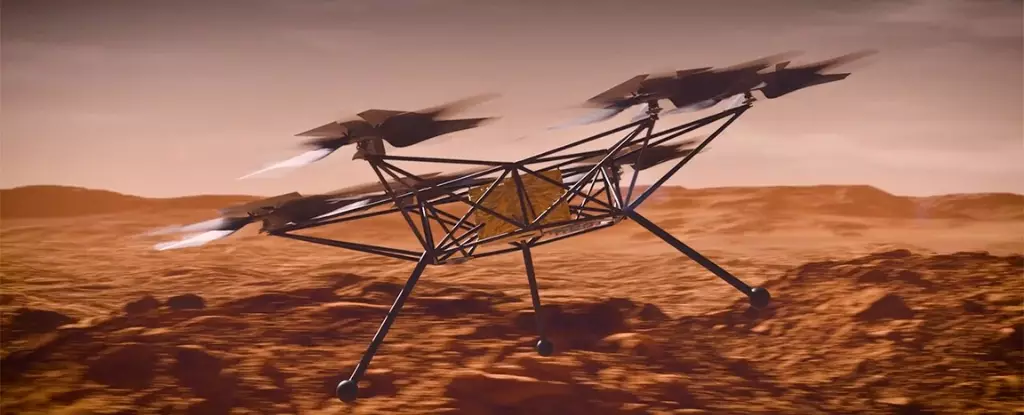The exploration of Mars has stepped into a new era, heralded by the innovation of aerial vehicles. The recent advances in drone technology, particularly showcased by NASA’s Ingenuity helicopter, have opened up exciting possibilities for future missions. As we look forward to NASA’s latest concept design—the Mars Chopper—we should analyze the implications this technology has for Martian exploration and how it can revolutionize our understanding of the planet.
In April 2021, Ingenuity made history as the first aircraft to achieve powered flight on another planet. Attached to the Perseverance rover, this small helicopter embarked on a series of flights that were intended as a proof of concept. Not only did it successfully display the viability of aerial movement in Mars’ thin atmosphere, which is less than 1% the density of Earth’s, but it also demonstrated the potential for scouting and surveying Martian terrain from the air.
Faced with the unique challenges of the Martian environment, Ingenuity’s design was meticulously crafted. The helicopter had to overcome not just the low atmospheric density but also the pervasive dust, which could interfere with its delicate machinery. Nevertheless, the success of Ingenuity, completing 60 flights and gathering crucial information for future explorations, set a standard for all subsequent aerial missions.
Building on the achievements of Ingenuity, NASA has released a computer rendering of the Mars Chopper—a next-generation aerial vehicle poised to expand our capabilities in exploring Mars. While Ingenuity served primarily as a technological demonstrator, the Mars Chopper is designed with significantly advanced features intended for more comprehensive scientific investigations.
Distinctly larger than its predecessor, the Mars Chopper showcases a design reminiscent of an SUV, boasting six rotors equipped with a total of thirty-six blades. This new configuration reduces blade size while enhancing lift efficiency, enabling the vehicle to carry a payload of up to 5 kilograms and travel distances of 3 kilometers. This capability is a game-changer, allowing for the transportation of scientific instruments essential for imaging, analysis, and terrain mapping.
Enhancing Scientific Research
The ability to carry advanced scientific equipment will allow the Mars Chopper to undertake critical research tasks that were previously challenging or impossible with ground-based rovers alone. For instance, it could scout for candidate locations for future human missions and analyze soil samples from hard-to-reach areas. As a dynamic tool in the Martian exploration arsenal, the Chopper significantly enhances the efficiency and depth of scientific research conducted on Mars.
Moreover, the collaborative effort between NASA’s Jet Propulsion Laboratory and Ames Research Center exemplifies the ingenuity of teamwork in overcoming the challenges of extraterrestrial exploration. This partnership also suggests a focused commitment to pushing the limits of exploration beyond Mars, potentially adapting this technology for use on other celestial bodies with similar conditions.
The advancements represented by the Mars Chopper model signal potential applications that extend beyond Martian exploration. Any extraterrestrial body with a solid surface and a sufficiently dense atmosphere could benefit from this evolving aerial reconnaissance technology. Envisioning the Mars Chopper in the context of future missions to Venus, Titan, or even exoplanets could fundamentally transform how humans and robots alike engage with distant worlds.
Furthermore, the emphasis on aerial reconnaissance fills a critical gap in the current exploration paradigm. While ground rovers significantly contribute to our understanding of planetary environments, they are inevitably limited to terrestrial terrains. Drones, on the other hand, can traverse expansive areas more rapidly and affordably, making them indispensable for future missions.
As we stand on the cusp of a new era in space exploration, the Mars Chopper embodies the promising future of aerial technology across various celestial bodies. Ingenuity’s successes have laid the groundwork, demonstrating the merits of powered flight in alien atmospheres. The Mars Chopper takes this concept further, establishing a new paradigm for scientific exploration that emphasizes flexibility, efficiency, and the exciting potential for enhanced collaboration in our quest to understand the universe. With each advancement, we draw closer to uncovering the mysteries that Mars and beyond hold, one flight at a time.


Leave a Reply